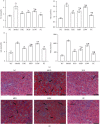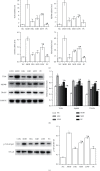Fuzi-Lizhong Decoction Alleviates Nonalcoholic Fatty Liver Disease by Blocking TLR4/MyD88/TRAF6 Signaling
- PMID: 36065267
- PMCID: PMC9440633
- DOI: 10.1155/2022/1637701
Fuzi-Lizhong Decoction Alleviates Nonalcoholic Fatty Liver Disease by Blocking TLR4/MyD88/TRAF6 Signaling
Abstract
Background: Fuzi-Lizhong decoction (FLD) derives from the ancient Chinese Pharmacopoeia and has been clinically used for years. The present study aimed to investigate the activities and underlying mechanisms of FLD against nonalcoholic fatty liver disease (NAFLD).
Methods: In vivo studies were conducted by inducing NAFLD in rats with a high-fat diet, and in vitro studies were performed on HL-7702 cells treated with oleic and linoleic acids. Total cholesterol (TC), triglyceride (TG), and blood glucose (Glu) levels were detected using an automatic biochemical analyzer. The expression of IL-2, IL-6, and TNF-α in sera and cell culture supernatants was measured by ELISA. The mRNA and protein levels of TLR4, MyD88, and TRAF6 were measured in liver tissue and HL-7702 cells using reverse transcription-quantitative polymerase chain reaction and western blot.
Results: FLD significantly reduced the TC, TG, Glu, FFA, IL-2, IL-6, and TNF-α levels in NAFLD rats and HL-7702 cells. Analysis of liver lipid content by Oil Red O staining revealed a significant increase in hepatic lipid accumulation in rats with NAFLD, but this lipid accumulation was reversed by FLD treatment. In addition, the mRNA expression levels of TLR4, MyD88, TRAF6, and NF-κB p65 as well as the protein levels of TLR4, MyD88, TRAF6, and NF-κB p65 were decreased after FLD treatment. FLD significantly reduced inflammation and improved collagen accumulation in vivo and in vitro by inhibiting the activation of the TLR4/MyD88/TRAF6 signaling pathway.
Conclusions: FLD exerted potent protective effects against NAFLD via TLR4/MyD88/TRAF6 signaling. These findings provide novel insights into the mechanisms whereby this compound acts as an anti-inflammatory agent and highlight the potential application of FLD in the treatment of acute liver failure (ALF).
Copyright © 2022 Jiayao Yang et al.
Conflict of interest statement
All authors declare that they have no conflicts of interest.
Figures





Similar articles
-
Protective Effect of Fuzi Lizhong Decoction against Non-alcoholic Fatty Liver Disease via Anti-inflammatory Response through Regulating p53 and PPARG Signaling.Biol Pharm Bull. 2020;43(11):1626-1633. doi: 10.1248/bpb.b20-00053. Biol Pharm Bull. 2020. PMID: 33132309
-
Gypenosides improves nonalcoholic fatty liver disease induced by high-fat diet induced through regulating LPS/TLR4 signaling pathway.Cell Cycle. 2020 Nov;19(22):3042-3053. doi: 10.1080/15384101.2020.1829800. Epub 2020 Oct 29. Cell Cycle. 2020. PMID: 33121337 Free PMC article.
-
Berberine inhibits liver damage in rats with non-alcoholic fatty liver disease by regulating TLR4/MyD88/NF-κB pathway.Turk J Gastroenterol. 2020 Dec;31(12):902-909. doi: 10.5152/tjg.2020.19568. Turk J Gastroenterol. 2020. PMID: 33626003 Free PMC article.
-
[Effect of Fuzi Lizhong decoction in reducing liver injury of rats with non-alcoholic fatty liver via activating AMPK and suppressing NF-κBp65 pathway].Zhongguo Zhong Yao Za Zhi. 2018 Aug;43(15):3176-3183. doi: 10.19540/j.cnki.cjcmm.2018.0094. Zhongguo Zhong Yao Za Zhi. 2018. PMID: 30200715 Chinese.
-
Alleviation of non-alcoholic fatty liver disease by Huazhi Fugan Granules is associated with suppression of TLR4/NF-κB signaling pathway.Clin Investig Arterioscler. 2021 Sep-Oct;33(5):257-266. doi: 10.1016/j.arteri.2020.12.007. Epub 2021 Mar 31. Clin Investig Arterioscler. 2021. PMID: 33810882 Review. English, Spanish.
Cited by
-
Herbal medicine as a potential treatment for non-alcoholic fatty liver disease.World J Gastroenterol. 2025 Mar 7;31(9):100273. doi: 10.3748/wjg.v31.i9.100273. World J Gastroenterol. 2025. PMID: 40061600 Free PMC article.
References
LinkOut - more resources
Full Text Sources
Miscellaneous

